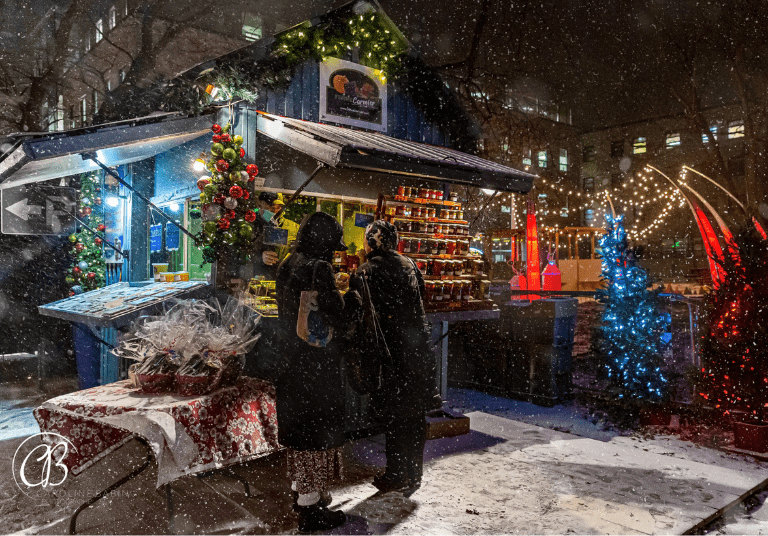There’s no better way to get into the holiday spirit than picking out your Christmas tree. A day of playing outside, looking for the most beautiful one, the one that will look great in your home! Spotlight on a unique tradition that’s a joy to revive, year after year.
Just like the good old days
While for some, U-pick fir harvesting is a must, for others it’s a chance to reminisce about the Christmases of yesteryear. For others, it’s more a chance to reminisce about the Christmases of yesteryear, when the harvest was a big party! Just as in the old days, young and old alike set off in meticulous search of “their” King of the Forests, the bravest, bushiest and most fragrant. It’s like welcoming a new member of the family.
But where does this tradition come from? It’s said that an ancient pagan rite called for a tree to be honored (the fir tree would have replaced the oak!(3)) near the date of the winter solstice, as it symbolized life. In this way, the rebirth of the Sun was celebrated.(4) In a way, it’s in the same spirit of festivity and celebration that the U-pick experience offered by the following companies fits in.
Ferme Quinn (Montérégie)
In Notre-Dame-de-l’Île-Perrot (just 20 minutes from Montreal), Ferme Quinn invites families to choose their dream tree, straight from their plantation. The activity begins with a ride on a tractor-drawn wagon to the fields. U-pick includes access to the animal barn and play area! Varieties available for picking: balsam fir, Fraser fir, white pine, Scots pine or blue spruce. Otherwise, a selection of freshly precut fir is available at the boutique.
Speaking of the boutique, back at reception, you can warm up with a hot drink. You’ll need to recharge your batteries before visiting the boutique from top to bottom, to complete your holiday meal with their many local products.
Did you know that…
- Around 85 million Christmas trees are planted worldwide every year(1).
- In Quebec, 4 main varieties are grown: the balsam fir (the most fragrant and considered the Christmas tree par excellence!), Fraser (originally from the United States and the 2nd most widely grown in the province), Canaan and Cook in the balsam line(2).
- The first Christmas tree in Quebec was decorated in 1781. It seems that German general Friedrich-Adolphus Riedesel, stationed in Sorel, had the idea of decorating his tree according to the customs of his country. However, it wasn’t until the 19th century that Christmas trees really took hold in Canada(3).
- According to MAPAQ, nearly 2,400,000 Christmas trees are sold in Quebec every year. In fact, the province produces and sells the largest number of trees, mainly from the Estrie and Chaudière-Appalaches regions(4).
Practicals infomrations
- What to bring Avoid unpleasant surprises by bringing a measuring tape with you when you pick your own. Outdoors, trees always tend to look smaller. And a good pair of gloves if you don’t want your fingers to be “gummed”.
- Are U-pick trees more expensive? Of course, prices are as varied as the trees themselves. However, this activity is not really more expensive than the cost of a pre-cut tree. At Verger Champêtre, for example, the price is $65 (plus taxes) for a tree of your choice, regardless of size. Otherwise, Ferme Quinn offers you a balsam or Fraser fir for $70 (up to 8 ft.).
- When is the best time to buy/pick your tree? Since most trees can be stored indoors for between four and six weeks, early December is the ideal time. Most of the trees sold here are cut in mid-November (6).
- Which to choose: balsam fir or Fraser fir? Apart from questions of look and smell, keep in mind that balsam branches are generally denser and more flexible, an aspect not to be overlooked if you have large ornaments! Fraser has the best thorn retention (7).
- How do I look after my tree? If you’ve opted for a tree that’s already been cut down, ideally you should cut off its “foot” by about 2 cm (or ask someone to do it for you when you buy it) just before placing it in its stand. This will keep it fresh for a long time. On this subject, don’t forget that the fir tree drinks mainly through its outer layers, which is why it’s important not to crush the bark or the sides of the trunk. As for watering, it’s best to fill the reservoir completely after installation, then check the water level every day. Check: not only must the stand contain water, but the trunk must also be soaked (6).
- What to do with your Christmas tree after the holidays? As early as January, many Quebec municipalities organize a collection of natural fir trees, which can be turned into mulch, used to make natural oil or sent for composting (5).
- And the big question: which tree is the most environmentally friendly? Due to a number of factors, not least the amount of pollution an artificial tree generates when it’s produced and thrown away, it’s far from preferable in terms of its environmental footprint. An artificial tree would have to be kept for at least 20 years to become more eco-responsible than a natural one. (7) The best option is still the simplest: cutting your own tree in a forest/producer near you.
In the end, what’s the greatest advantage of picking your own Christmas tree? Quite simply because it’s a real pleasure to be able to choose it in its natural environment, to greet it with your fingertips, to smell it, to imagine it beautifully decorated. What’s more, its freshness is guaranteed, so you can admire its flamboyance for weeks to come!
Sources
(1) Radio-Canada, Connaissez-vous bien votre sapin?, 2018
(2)Gouvernement du Québec, Culture des arbres de Noël, 12 septembre 2022
(3)Radio-Canada, Les décorations de sapin de Noël, une tradition vieille de plusieurs siècles, 2020
(4)Noovo, Le sapin de Noël d’hier à aujourd’hui, 30 septembre 2022
(5)Le Devoir, Naturel ou artificiel, quel sapin est le plus vert?, 6 décembre 2021
(6)Noovo, Sapin naturel 101 : comment choisir et entretenir son sapin de Noël, 24 septembre 2022
(7)Quatre,95 – Urbania, Comment bien choisir son sapin de Noël, 18 novembre 2022







